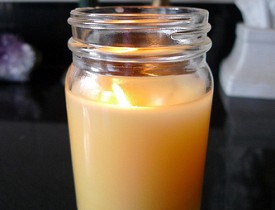7 Practical Uses for Beeswax
 No one has a fondness for stinging insects, but when it comes to the honeybee, humanity owes an enormous debt. Honeybees produce a multitude of products that benefit us. In the process of producing honey, bees build honeycomb cells of wax where honey, pollen, and baby bees are stored. Beeswax is a by-product of honey production, but has a multitude of uses in the cosmetic, food, and pharmaceutical industries – for example, producing high quality creams, protecting and aging cheese, or coating pills.
No one has a fondness for stinging insects, but when it comes to the honeybee, humanity owes an enormous debt. Honeybees produce a multitude of products that benefit us. In the process of producing honey, bees build honeycomb cells of wax where honey, pollen, and baby bees are stored. Beeswax is a by-product of honey production, but has a multitude of uses in the cosmetic, food, and pharmaceutical industries – for example, producing high quality creams, protecting and aging cheese, or coating pills.
To use this versatile product at home, purchase beeswax in a hardware or craft store. A one pound block of beeswax may cost anywhere from $4-20, depending on the grade and whether it’s filtered or unfiltered.
Use Beeswax Alone
Without adding anything to it, you can utilize beeswax in the following ways:
- In the woodshop, drip a little melted beeswax on rusted nuts or bolts to remove them more easily. When screwing into new wood, dip screws into liquid wax to reduce the risk of splitting or cracking wood.
- Make your own beeswax candles. The advantages of beeswax over common paraffin wax candles are that they burn cleaner and longer with a brighter flame. Churches often burn beeswax candles because they smoke and drip much less. For individuals with sensitivity to smoke and intense fragrances, beeswax candles are a good alternative.
- Do your drawers or windows stick? Try rubbing the stub of a beeswax candle or block along the edges of the door and tracks.
- Run your sewing thread against a block of beeswax a few times. It will slide through the fabric more easily and prevent longer threads from tangling.
Make a Natural Beeswax Compound
Here is a basic old-fashioned recipe for making a beeswax compound, an inexpensive alternative to commercial wax-based products:
Gently melt at low temperature 1 part beeswax, shaved or diced, on a hot plate or in a double boiler.
Once wax melts, remove from heat and add an equal amount of turpentine (a natural thinner derived from pine sap) with ½ part boiled linseed oil.
Mix well and let cool to a creamy consistency.
Warning: Do not add the turpentine or mix it in over a flame as it is a combustible product.
After cooling, use the mixture as follows:
- Condition and waterproof leather boots, bags, saddles, and so on by rubbing into the leather with a dry, clean cloth, working in well along seams. Let dry, then buff to shine.
- Coat hand tools, shovels, and cast iron pieces (not cast iron cookware, though -- turpentine is dangerous for human consumption!) to prevent rust formation. Treat wood handles as well, to preserve and protect them from degrading.
- Use as a finish on bare wood. Apply paste with a cotton rag, working it into the grain, then buff.
For help with beeswax-based (or other) home improvements, hire a professional handyman.
Updated December 28, 2017.
Looking for a Pro? Call us (866) 441-6648

Cleaning Average Costs
Cleaning Services Experiences

Emergency Garage Door Replacement

Compare At Least 4 Painting Bids - The Lowest Could Be The Best!



